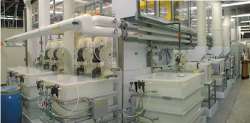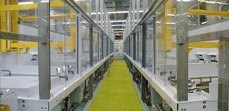Consolidating Electronics Plating Lines
ITT Industries, Cannon reviewed its plating setup and developed a strategy for the plating department. Its first step was to consolidate the pr'ous metal plating lines into one automated line...
#electronics
At ITT Industries, Cannon, cycle time is essential to the efficiency of the electronics plating department. This was top in the minds of Steve Chou, lead manufacturing engineer for plating, Amir Saket, manufacturing engineering manager and other engineers when they reviewed the plating systems and strategies at the company. In particular, they wanted to improve cycle times and ensure environmental compliance while improving customer satisfaction.
The pr'ous metal plating lines within the department were the first reviewed. This section of the plating department had three lines. Two lines were manual and one was a 25-year-old automated line. "None of these lines was being fully utilized," stated Dr. Chou.
Featured Content
The strategy was to consolidate the three lines into one automated line with maximum flexibility and a minimum discharge of waste. A cross-functional team consisting of Cannon employees was formed to work out the performance requirements and then design sp'fications of the plating system. The team focused on the waste segregation and minimization. However, Cannon's needs did not fit "off-the-shelf" equipment, so it had to work closely with the vendors to design a system that was uniquely adapted to Cannon and its customers' needs. "There was a lot of give and take," noted Dr. Chou. "It was a real learning experience for all of us. We had to find vendors who were willing to work with us to really meet our needs."
As stated, Cannon could not work with off-the-shelf equipment because of the variety and number of parts it plates (900 different electrical contact parts inside various connector bodies). "We supply parts to a number of industries, from communications to aerospace," Dr. Chou commented. "Our customers are worldwide, ranging from IBM to Boeing." Cannon worked with HBS Equipment to develop an enclosed automated system that could plate parts using barrel, vibratory basket, rack or wire fixturing.
Only 5% of the parts are racked or wire fixtured, however. The rest of the parts are barrel plated in a rotational or vibratory barrel. Heavier, thicker parts are plated in the rotational barrels, while more delicate parts are run in the Vibroset vibratory plating barrels from ECI Technology.
"We use the vibrating barrels for our delicate parts that cannot withstand the tumbling action of the barrels," noted Dr. Chou. "It also helps us successfully plate into the blind holes we have on many of these tiny parts."
A constant current is applied to the parts in the vibratory barrel, equalizing the deposition rate over the entire part. There are numerous cathode button contact in the bottom of the basket and numerous parts in the basket, all in contact with each other. The amplitude and frequency are carefully chosen to move the parts around the basket but avoid vigorous jumping action that could even momentarily break the electrical contact.
This constant contact also allows for even current distribution over the parts, thus eliminating the dogboning effect that may occur with other types of plating (see sidebar). The vibratory action blurs the distinction between the edges and flat portions of the parts.
Anodes are placed outside of the vibratory barrel, baffled by the walls of the basket. The vibratory action also helps blur the distinction between high and low current density regions and improve throwing power. Parts move around the barrel at a predetermined rpm. Parts can slide over each other, but there is little impingement, which could cause scratching or defects.
Each fly bar on the line can hold up to three vibratory barrels, three rotational barrels or three racks. Sixteen different jobs can run on the line at one time because of the random loading software program built into the system. Presently, the Cannon system has approximately 35 plating r'pes programmed into the system, which has the capacity to handle hundreds more. Parts are loaded manually, and that is the last time they are touched by human hands. After loading, the system automatically runs them through the program designated by the plating operator.
"We went with an enclosed system and new chemical scrubbers to significantly improve the working environment for employees," commented Dr. Chou. The work place is very clean because the chemical fumes from the cyanide plating processes are contained in the enclosure and treated with scrubbers. All maintenance is done behind the enclosed plating line. Filtration systems, pumps, piping, metering systems, etc. are contained behind the line so they do not interfere with the actual plating process. Also, the plating line does not have to be "opened up" for chemical additions, filter changes or other maintenance procedures. "With the old line we had to pull drums to the process tanks to make chemical additions. With our new line, we pump acid solutions to tanks from the back of the tank."
The new pr'ous metal plating line at Cannon has improved cycle time, product quality, saved money, improved worker safety and environmental conditions and expanded plating capabilities, and the entire consolidation effort was accomplished without any interruption to customer service.
Because of the success with the pr'ous metals line, Cannon is now working on consolidation of its other plating lines. This is an even taller order, since there are five lines in this section of the plating department. "We have successfully consolidated one section, and that has given us the confidence to tackle the next section. We are able to do this without interruption in customer service. Our customers actually benefit from the consolidation and improved plating processes as much as we do," maintained Dr. Chou.
RELATED CONTENT
-
Vertical Acid Copper Plating for PCB Manufacturing
Developments expand in the world of printed circuit boards.
-
Finishing High Reliability, Function Critical Parts
From safety critical automotive and aerospace components to lifesaving medical micro-components and implantable devices, Indiana-based Electro-Spec finishes applications that require zero failure rates.
-
Electroplating, Electrochemistry and Electronics - The 15th William Blum Lecture - Part 1
This article is the first of four parts of a re-publication of the 15th William Blum Lecture, presented at the 61st AES Annual Convention in Chicago, Illinois, on June 17, 1974. Dr. George Dubpernell reviews the history and extent of commercial plating, then delves into the electrochemical science, including potentials, overvoltage and connections to electronics.




















